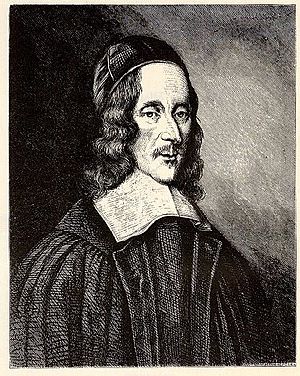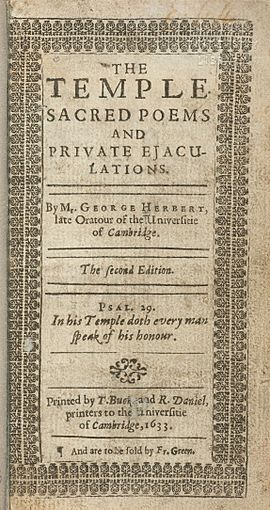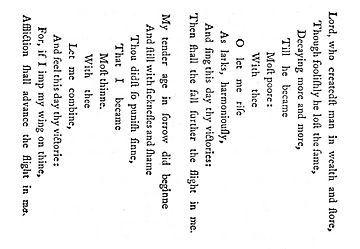George Herbert facts for kids
Quick facts for kids
George Herbert
|
|
|---|---|

Portrait by Robert White in 1674 (National Portrait Gallery)
|
|
| Born | 3 April 1593 Montgomery, Wales |
| Died | 1 March 1633 (aged 39) Bemerton, Wiltshire, England |
| Occupation |
|
| Alma mater | Trinity College, Cambridge |
| Literary movement | Metaphysical poetry |
| Notable works | The Temple, The Country Parson, Jacula Prudentum |
George Herbert (born April 3, 1593 – died March 1, 1633) was an English poet, speaker, and priest. He was part of a group called the Metaphysical poets. People remember him as one of Britain's best writers of religious poems.
George Herbert was born in Wales into a rich and artistic family. He grew up mostly in England and got a great education. This led him to Trinity College, Cambridge, in 1609. He wanted to become a priest, but he first became the University's Public Orator. This job meant he gave official speeches. He even caught the attention of King James I. He also served in the Parliament of England for a short time.
After King James died, Herbert decided to become a priest. In his mid-thirties, he gave up his political dreams. He became a priest in the Church of England. He spent the rest of his life as the leader of a small church in a village called Fugglestone St Peter. He was known for taking great care of the people in his church. He would visit them when they were sick and give food and clothes to those who needed help. He was not a healthy person and died at age 39 from a lung disease called consumption (tuberculosis).
Contents
Biography
Early Life and Education
George Herbert was born on April 3, 1593, in Montgomery, Wales. His father, Richard Herbert, died when George was only three years old. His mother, Magdalen, was a friend and supporter of many writers and artists, including the poet John Donne. George was one of ten children in a wealthy and powerful family. His family was important in government, and they were related to the Earls of Pembroke. His mother made sure all her children received a good education.
George's oldest brother, Edward, became a soldier, diplomat, and philosopher. His younger brother, Henry, became the Master of the Revels. This was an important job in charge of entertainment for Kings Charles I and II.
George went to Westminster School around age 12. In 1609, he received a scholarship to Trinity College, Cambridge. He earned his first degree and then a Master's degree in 1616. After that, he became a teacher at the college. In 1620, he became the University's Public Orator. This meant he was the official speaker for the university. He held this job until 1627.
In 1624, George Herbert became a member of Parliament. This was a step towards a career at the King's court. However, King James I died in 1625. This changed Herbert's plans. He then decided to focus more on a future in the church.
In 1626, he was given a special church position called a prebend in Leighton Bromswold. He was not yet a priest. He helped raise money to fix the church building there. His friend Nicholas Ferrar also started a small religious community nearby.
Marriage
Around 1628 or 1629, George Herbert met Jane Danvers. She was ten years younger than him. They quickly liked each other and got married on March 5, 1629.
Becoming a Priest
In 1629, Herbert decided to become a priest. The next year, he was made the leader of a small church area called a parish. This was in Fugglestone St Peter with Bemerton, near Salisbury. He was in charge of two small churches. He lived there, preached, and wrote his famous poems. He even used his own money to help rebuild the Bemerton church and the house next to it.
While in Bemerton, Herbert worked on his collection of poems called The Temple. He also wrote a guide for village priests called A Priest to the Temple. This book is still important today. He and his wife took in three nieces who had no parents. They went to church services twice a day. Twice a week, Herbert would go to Salisbury Cathedral to attend services. He also enjoyed making music with the cathedral musicians.
Death
George Herbert's time in Bemerton was short. He had poor health for most of his life. In 1633, he died from consumption (tuberculosis). He had only been a priest for three years.
Poetry
Herbert wrote poems in English, Latin, and Greek. Before he died, he sent his poems to his friend Nicholas Ferrar. He told Ferrar to publish them if they could help "any sad person." Otherwise, he said to burn them. In 1633, all his English poems were published. The book was called The Temple. It became very popular and was printed many times.
All of Herbert's English poems are about religious topics. They are known for being direct and using clever comparisons. These comparisons are called "conceits" in Metaphysical poetry. For example, in his poem The Windows, he compares a good preacher to glass. He says God's light shines through the preacher more clearly than through his words.
Herbert also made his poems look interesting on the page. He used different rhyme schemes and line lengths. Some of his poems are called pattern poems. For example, "The Altar" is shaped like an altar. The words in "Easter Wings" were printed sideways on two pages. This made the poem look like a pair of wings. These shapes helped to add to the poem's meaning.
Herbert used many clever ways to share his message. In "The Collar", the poem seems messy at first. But then, the last few lines become regular. This shows how order is needed.
For a long time, people admired Herbert for his religious faith. But his clever poetic style was not fully appreciated again until centuries later.
Prose
Herbert's only prose work is A Priest to the Temple. It gives helpful advice to priests in the countryside. He suggests that everyday things, like plows or dances, can teach us about "Heavenly Truths." This book was first published in 1652.
Like many writers of his time, Herbert collected proverbs. These are short, wise sayings. His book Outlandish Proverbs was published in 1640. It had over 1000 sayings from many countries. Some of these sayings are still used today. For example, "His bark is worse than his bite" and "Who is so deaf, as he that will not hear?" More proverbs were added to a later collection called Jacula Prudentum.
Musical Settings
George Herbert came from a family that loved music. His mother was friends with famous composers. George himself played the lute and viol. He even "set his own poems" to music. He enjoyed music throughout his life. His friend and biographer, Izaak Walton, said Herbert played the lute even when he was very sick.
Over 90 of Herbert's poems have been set to music for singing. Some have been set many times. In his own time, composers like Henry Purcell used his poems. Later, the Wesley brothers used about 40 of his poems for Methodist hymns. One poem, "Teach me my God and King," is in many hymnals. Another, "Let all the world in every corner sing," is also very popular. His work has been translated into Spanish, German, and other languages for music.
In the 20th century, many modern composers set his poems to music. These include Ralph Vaughan Williams, Benjamin Britten, and Judith Weir.
Legacy
The first picture of George Herbert was made long after he died. It was an engraving by Robert White in 1674. This picture is now in London's National Portrait Gallery. It was used as a model for many later pictures of him.
Later artists also honored Herbert. William Dyce painted "George Herbert at Bemerton" in 1860. It shows the poet in his garden by a river. In the background, you can see Salisbury Cathedral, where he loved to hear music. His lute and a fishing rod are nearby. Another painting shows George Herbert and his mother. It includes a musical instrument called a virginal.
Many churches and cathedrals have stained glass windows honoring Herbert. You can find them in Westminster Abbey and Salisbury Cathedral. His own church in Bemerton has a window dedicated to him and his friend Nicholas Ferrar. There is also a statue of George Herbert at Salisbury Cathedral.
Veneration
| George Herbert | |
|---|---|
|
The Herbert niche, Salisbury Cathedral
|
|
| Venerated in | Anglican Communion, Lutheranism |
| Feast | Feb. 27 (Anglican), Mar. 1 (Lutheran) |
George Herbert is remembered in the Church of England and the Episcopal Church on February 27. He is also honored on March 1 in the Lutheran church calendar. This is the day he died.
A quote from Herbert's poem "The Church Porch" is written on the wall of St. John's Church, Waterloo. It says: "All may have, if they dare try, a glorious life, or a grave."
Works
- The Temple (1633) - His most famous collection of religious poems.
- A Priest to the Temple, or, The Country Parson His Character and Rule of Holy Life (1652) - A guide for rural clergy.
- Outlandish Proverbs (1640) and Jacula Prudentum (1652) - Collections of wise sayings.
See also
 In Spanish: George Herbert para niños
In Spanish: George Herbert para niños






